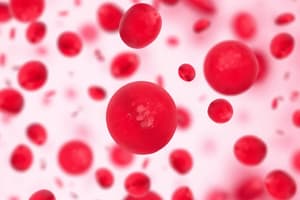Podcast
Questions and Answers
Match the following causes with the related type of anemia:
Match the following causes with the related type of anemia:
Nutritional deficiency (Vitamin B12) = Megaloblastic anemia Faulty iron absorption = Iron deficiency anemia Defects in DNA synthesis = Megaloblastic anemia Excessive blood loss = Iron deficiency anemia
Match the laboratory findings with the type of anemia they indicate:
Match the laboratory findings with the type of anemia they indicate:
Decreased serum ferritin = Iron deficiency anemia Macrocytosis = Megaloblastic anemia Increased TIBC = Iron deficiency anemia Hypersegmented neutrophils = Megaloblastic anemia
Match the specific condition with its related potential cause of anemia:
Match the specific condition with its related potential cause of anemia:
Pregnancy = Both anemias Gastric Resection = Iron deficiency anemia Dietary deficiency of B12 = Megaloblastic anemia Peptic ulcer = Iron deficiency anemia
Match the type of anemia with the key blood film findings:
Match the type of anemia with the key blood film findings:
Match the clinical scenario with the most likely cause of megaloblastic anemia:
Match the clinical scenario with the most likely cause of megaloblastic anemia:
Match the blood test result with its interpretation in iron deficiency anemia (IDA):
Match the blood test result with its interpretation in iron deficiency anemia (IDA):
Match the condition with the type of anemia it may primarily cause:
Match the condition with the type of anemia it may primarily cause:
Match the laboratory test value with its likely change in megaloblastic anemia compared to normal:
Match the laboratory test value with its likely change in megaloblastic anemia compared to normal:
Match the cause of anemia to the mechanism by which it leads to anemia:
Match the cause of anemia to the mechanism by which it leads to anemia:
Associate the specific blood film finding with the relevant detail it reveals about the affected red blood cells:
Associate the specific blood film finding with the relevant detail it reveals about the affected red blood cells:
Match each clinical finding with the type of anemia where it is most commonly observed:
Match each clinical finding with the type of anemia where it is most commonly observed:
Match the treatment approach with its primary aim in managing the respective type of anemia:
Match the treatment approach with its primary aim in managing the respective type of anemia:
Match the laboratory finding with its specific association with iron metabolism or red blood cell status:
Match the laboratory finding with its specific association with iron metabolism or red blood cell status:
Match the specific aspect of DNA synthesis or deficiency with the related effect in megaloblastic anemia:
Match the specific aspect of DNA synthesis or deficiency with the related effect in megaloblastic anemia:
Match the potential underlying cause of iron deficiency anemia with its direct implication:
Match the potential underlying cause of iron deficiency anemia with its direct implication:
Match the cause of macrocytosis to the associated condition and/or disease state:
Match the cause of macrocytosis to the associated condition and/or disease state:
Match the treatment with its role or action in anemia management
Match the treatment with its role or action in anemia management
Match the laboratory find with its role in diagnosis of anemia.
Match the laboratory find with its role in diagnosis of anemia.
Associate each type of anemia with its distinct etiology and/or cause:
Associate each type of anemia with its distinct etiology and/or cause:
Understanding clinical scenarios of anemias requires knowing that there are a variety of common symptoms. Match a common symptom from anemia to its cause.
Understanding clinical scenarios of anemias requires knowing that there are a variety of common symptoms. Match a common symptom from anemia to its cause.
Flashcards
Iron Deficiency Anemia
Iron Deficiency Anemia
Most common nutritional disorder, often half of anemia cases.
Nutritional iron deficiency
Nutritional iron deficiency
Insufficient iron intake, such as from a poor diet.
Faulty iron absorption
Faulty iron absorption
Conditions or surgeries impairing iron absorption like Crohn's or gastric resection.
Increased iron demand
Increased iron demand
Signup and view all the flashcards
Iron deficiency anemia
Iron deficiency anemia
Signup and view all the flashcards
Blood Film in IDA
Blood Film in IDA
Signup and view all the flashcards
Lab findings in IDA
Lab findings in IDA
Signup and view all the flashcards
Blood film IDA
Blood film IDA
Signup and view all the flashcards
Serum Ferritin & IDA
Serum Ferritin & IDA
Signup and view all the flashcards
Megaloblastic anemia
Megaloblastic anemia
Signup and view all the flashcards
Cause of Megaloblastic anemia
Cause of Megaloblastic anemia
Signup and view all the flashcards
Nutritional cause of Megaloblastic anemia
Nutritional cause of Megaloblastic anemia
Signup and view all the flashcards
Increased demand of B12
Increased demand of B12
Signup and view all the flashcards
Lab diagnosis for Megaloblastic anemia
Lab diagnosis for Megaloblastic anemia
Signup and view all the flashcards
Blood film for Megaloblastic anemia
Blood film for Megaloblastic anemia
Signup and view all the flashcards
Study Notes
Iron Deficiency Anemia
- This is the most common nutritional disorder globally.
- Accounts for about half of all anemia cases.
- Diagnosis is confirmed by low iron stores and below-normal hemoglobin levels.
- Blood film shows microcytic hypochromic cells.
Causes of Iron Deficiency Anemia
- Nutritional deficiency: Insufficient iron intake due to poor diet or imbalanced vegetarianism.
- Faulty or incomplete iron absorption: Occurs in conditions like achlorhydria, after gastric resection, or in Crohn's disease.
- Increased iron demand: Seen in pregnancy and during childhood growth years.
- Excessive blood loss: Due to hookworm, or acute and chronic hemorrhages like peptic ulcers, stomach cancer, or heavy menstruation.
Laboratory Findings in Iron Deficiency Anemia
- Hemoglobin and PCV are decreased; red cell indices (MCV, MCH, MCHC) are also decreased.
- Blood film examination shows hypochromic, microcytic red cells with anisocytosis.
- Reticulocyte count is typically normal or decreased, but increases with iron treatment.
- Platelet count is normal but may increase following acute blood loss.
- Serum iron is low, while TIBC is high because TIBC measures transferrin.
- Serum ferritin is decreased because serum ferritin measures iron stores.
Megaloblastic Anemia
- Anemia resulting from inhibited DNA synthesis during red blood cell production.
- Impaired DNA synthesis prevents cell cycle progression from the G2 growth stage to mitosis, leading to continuous cell growth without division and resulting in macrocytosis.
- Most often caused by hypovitaminosis, specifically vitamin B12 or folate deficiency.
Causes of Megaloblastic Anemia
- Nutritional: dietary Vitamin B12 or folate deficiency.
- Malabsorption: can be caused by celiac disease, Crohn's disease, or gastric carcinoma.
- Increased demand: pregnancy, infancy, and growth requirements.
- Defects in DNA synthesis: can stem from congenital causes, acute severe pancreatitis, fish tapeworm infestation, or therapy with cytochemical drugs.
Laboratory Diagnosis of Megaloblastic Anemia
- Hemoglobin concentration and RBC count are below normal, while MCV is high (>100 FL).
- Blood film shows macrocytes with ovelocytes.
- Leukocytosis and platelets are moderately reduced.
- There is a presence of hyper-segmented neutrophils in blood film.
- Biochemistry may show increased unconjugated bilirubin.
- Decreased serum vitamin B12 and folate concentrations.
Causes of Macrocytosis other than Megaloblastic Anemia
- Pernicious anemia.
- Liver disease.
- Reticulocytosis.
- Alcoholism.
- Hypothyroidism.
Studying That Suits You
Use AI to generate personalized quizzes and flashcards to suit your learning preferences.




